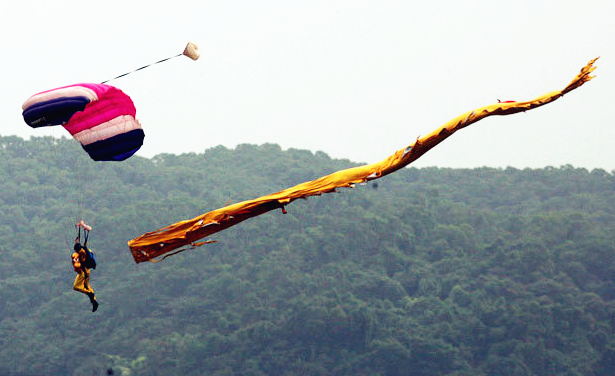2008 (Nov 4-9)
THE 7th China International Aviation & Aerospace Exhibition, Airshow China 2008, opened on November 4 with net indoor static display area of 13,000sqm for sponsors and 11,000sqm for international and domestic exhibitors, respectively nearly 6,000sqm and 2,000sqm more than two years before. Exhibitors from more than 35 countries and territories and nearly 600 aviation and aerospace manufacturers and designers were at the show with more than 60 aircraft on display.
China Aerospace Science & Technology Corp (CASC) showcased actual objects, models and photographs of its scientific achievements. These included launch vehicles and technology, manned space flight, satellites and space exploration, satellite applications systems, missiles, unmanned aerial vehicles (UAV), missile weapon systems, space technology and applications along with aerospace services. The display area of 3,500sqm was in Sections B and D of No 2 Exhibition Hall.
ZY Series resources satellite system and applications, communications satellite system and applications, and other space technologies were highlighted. A series of hi-tech emergency command systems represented by Beidou Satellite Navigation & Positioning System and satellites such as Navstar and Comstar, plus meteorological satellites that played a vital role in the Sichuan Earthquake rescue last May, were major attractions.
The Shenzhou spacecraft was launched with three crewmembers this September 25 by a Long March 2F (CZ-2F) rocket that lifted off from Jiuquan Satellite Launch Centre at 21:10 CST. The mission lasted three days, after which the craft landed safely in Siziwang Banner in Central Inner Mongolia on September 28 at 17:37 CST.
The extra-vehicular activity carried out during the flight made China the third country to have conducted an EVA, or spacewalk, after Russia/the Soviet Union and the United States.

Space station
Shenzhou-7 was the third human mission of the Chinese space programme. The mission, which included spacewalks by Zhai Zhigang and Liu Boming, marked commencement of the second phase of the government’s Project 921. Planned next are the Shenzhou-8 unmanned space laboratory module, Shenzhou-9 unmanned cargo mission, then the docking of a manned Shenzhou-10 in late 2010 with Shenzhou-11 later delivering the crew. The third and last phase will be creation of a permanent space station.
The test orbital module of Shenzhou-7, the core part of the spacecraft, along with a 1:1 model of the re-entry module, was exhibited -- the very first public presentation. Visitors could sit inside the re-entry module and imagine how a taikonaut feels.
A model space emergency response system, a model lunar lander that collects dust samples and photographs the moon surface representing the second phase of lunar exploration, 1:10 models of launch vehicles such as LM-2, 3 and 5, an actual rocket engine for the LM-2F Launch Vehicle, a model of a micro-UAV concept demonstrator joined other exhibits of delicacy and frontline space technology.
UAVs can be remote controlled or fly pre-programmed flight patterns or more complex dynamic automation systems. UAVs are currently used in a number of military roles, including reconnaissance and attack. They are also used in a small but growing number of civil applications such as firefighting when a human observer would be at risk, police observation of civil disturbances and crime scenes, and reconnaissance in natural disasters. UAVs are often preferred for missions that are too “dull, dirty, or dangerous” for manned aircraft.
China officially launched its lunar exploration programme in 2003. A three-step strategy -- orbiting, landing and sample return -- was formulated.
Orbiting -- the Chang’e I satellite was successfully launched in October 2007 for exploration from a lunar orbit.
Landing -- a lunar lander and rover for soft landing and detailed survey on the moon surface is to be launched in 2013.
Sample return -- a lunar lander to bring regolith soil back to Earth via a sample return capsule is to be launched in 2017.
Achievements
Meanwhile, China Aerospace Science & Industry Corp (CASIC) showcased nearly 200 achievements in aerospace defence, IT and equipment manufacture -- especially unmanned aircraft, ship and aerial vehicles -- Lu Xiaoge, director of the CASIC Publicity Department, said.
CASIC also exhibited logistical, civil and military dual-purpose and unmanned equipment themed at China Earthquake & Rescue in Sections A and C of No 2 Exhibition Hall.
Tianxiang No 1, the first maritime unmanned climate survey boat in China whose application during the Olympics heralded the first time for such a vessel to conduct a metrological sounding mission, was also displayed.
The 1:15 mock-ups of the small white Emergency Communications Command Vehicle equipped with satellite, ultrashort wave, GPS, microwave radio relay and other communications devices, and the small green Communications Vehicle equipped with wired and wireless communications devices and communications interface with shortwave, ultrashort wave, maritime satellites, GPS and GSM communications functions, were on display in the No 2 Exhibition Hall. The two small vehicles are flexible and adaptable to complex terrain, and thus played important roles in the Sichuan Earthquake rescue, according to a CASIC spokesperson.
Meanwhile, 2008 Beijing Olympic Games up-to-date technologies such as Olympic Games Mount Everest torch relay direct broadcast vehicle, eticket (RFID) system, Magic Globe and Chinese Painting Scroll at the Opening Ceremony, printed circuit board for fireworks control system, emergency management simulation system, overall technical plan for Olympic Games environmental engineering, combustion security simulation system of Main Torch at Bird’s Nest and security system for Olympic Games developed by CASIC were showcased at the hall.
Missiles for peace
A full range of long-distance, short-distance, ground-to-ground and air-to-air missiles catered to amateur military enthusiasts, Lu said, adding, “Missile weaponry equipment ensures a firm national defence and relatively stable and peaceful living environment.”
The just-concluded merger of China Aviation Industry Corp I and II into the China Aviation Industry Corp Group (AVICG) presented its strength and growth brand with a strong array of products and projects at No 2 Exhibition Hall. The exhibit area of the new company that then oversaw aircraft manufacturing in China encompassed 8,000sqm.
Sixty-nine subsidiaries of AVICG displayed military and commercial aircraft, engines, helicopter, UAV, air-borne systems and weaponry fire-control systems for fighters, bombers, transport planes and trainer aircraft. Also displayed were the WS-10A Taihang engine, small and medium turbojet engines and a micro-turbine.
The new AVIC and China National Aviation Technology Import & Export Co (CATIC) shared a booth in Hall 2 with an area of 247sqm for static display, business discussions and academic exchanges. The major products on show were the FC-1 fighter, Mountain FTC-2000 trainer, MA60 regional propeller aircraft, ARJ21regional jet, Anjian and Tianyi 3 UAVs, and flight deck simulation system, ejection seat and Xiaolong amour uniform.
Virtual flight
The most dynamic part of the No 3 Exhibition Hall was a LE-500 Flight Training Simulator and four other simulators in an area where anyone could experience the challenges and thrills of flying a plane.
The LE-500 Flight Training Simulator offered virtual flight above the mountains and rivers while the S&S-1 Combat Flight Simulator reproduces another thrilling and exciting experience in the air.
Moreover, EC225 helicopters of the Nanhai No 1 Rescue Flying Service of the Ministry of Communications that took part in the Sichuan earthquake rescue, a Super Puma helicopter and J-41 aircraft of the Hong Kong Government Flying Service (GFS) were displayed at the airshow.
Aircraft stunts performed
J-10 & MA-600
THE People’s Liberation Army Air Force had sent to the airshow two J-10 fighters, two J8D aerial refuel jets, and the indigenously produced FBC-1 Flying Leopard fighter-bomber, which was characterized as a “multi-mission all-weather supersonic fighter bomber fully independently developed by China.”
Also in the PLA lineup were the HU-6 and some other aircraft along with the China Air Force Parachute Squadron that staged aerobatic stunts.
Meanwhile, China Aviation Industry Corp Group had dispatched the L-15 Falcon advanced jet trainer, MA-600 regional passenger aircraft, Z11 utility helicopter, Seal H425 helicopter, Y12 turboprop utility aircraft and LE-500 Little Eagle trainer aircraft for aerobatic flights.
Moreover, EC225 helicopters of the Nanhai No 1 Rescue Flying Service of the Ministry of Communications that took part in the Sichuan earthquake rescue in May also performed.
A380
Airbus A380, the world’s largest passenger jet, landed at Zhuhai Airport on Monday. The super-jumbo jet was on static display and performed seven-minute flying demonstrations on business days and the first of the public days.
The double-decker jetliner, which was developed in France by the multinational European aircraft manufacturer, A380 has a cabin that holds a pub, cinema, resting and business areas. Airlines can use the cavernous hold to provide whatever their imaginations dream up: cafeteria, playroom, nightclub, casino, bedrooms, showers, treadmills, duty-free store, business centre, etc.
Visitors could also discover the attributes of the A350 XWB cabin interior in a portable mock-up at the airshow. The display of the A380 and mock-up of A350 XWB triggered a ticket-buying rush by airshow fans, according to a Zhuhai Airshow Co Ltd spokesperson.
In addition, the Bombardier Challenger 604 business jet, Diamond Star DA 40 and DA 42 light aircraft, Cirrus SR22 light aircraft, Gulfstream G200 and G500 business jet, Beechcraft Bonanza G36 and other planes were also exhibited.
Suryakiran Aerobatic Team
The Indian Air Force’s Suryakiran Aerobatic Team (SKAT) performed daily on trade days and twice on public days.
The Suryakiran Team was led by Wing Cmdr Joy T Kurien while the IAF contingent was headed by Group Capt A Saxena. The 12-aircraft SKAT team was supported by a contingent of 48 officers and 88 airmen. The contingent was ferried by two AN-32s and one IL-76.
Aerial refueling
Aerial refueling by a Su-27, Su-30 and IL-78, the latter designed for in-flight refueling of various airplanes, was performed at the first Airshow China in 1996. This time, home-made aircraft in-flight refueling were carried out on a HU6 aircraft and two J8D fighters. With a fixed refueling probe, the J8D which first flew in 1990, was the first PLA fighter capable of mid-air refueling, and serves in both PLAAF and PLANAF units.
Other flight performances
The Bombardier Challenger 605 business jet, Global Express XRS aircraft and CRJ 900 regional jet, Gulfstream G150 aircraft, Avion Pacific C90GTI and Hawker 4000, Zhuhai Apollo Aero Club’s Apollo-2, MCR-4S and Seawind 300C, Xi’an Westjet Aircraft Co Ltd’s light aircraft and helicopter and many others gave daily demonstration flights.
Air Force flexes defense muscles
THE People’s Liberation Army Air Force, with a history of 59 years, demonstrated its defence capabilities by performing aerial flights with the formidable new Chinese fighter jet J-10, conducting in-flight fueling with the H-6U tanker, and demonstrating precision parachuting at China Airshow Zhuhai.
J-10 fighter bomber
The J-10 fighter bomber was in the limelight. It is a modern 4th-generation multi-role air combat and single-seat tactical fighter. The J-10's defensive capabilities would be formidable, as would its ability to perform all-weather strikes with new precision-guided weapons.
It was equipped with a new low-light targeting pod, which was developed with Russian assistance, to mark targets for laser and weapons guided by navigation satellite. It appears that the J-10 may be able to carry up to eight 250kg bombs, along with two refueling tanks and two PL-9C AAMs. It has a combat radius of 1,000km and is designed for point defensive warfare.
With maximum speed of 1,500km/h and more than 1600 km of combat radius, the J-10 fighter bomber was then the most advanced fighter developed by China.
Most visitors and experts claimed “very impressive” after watching J-10’s performance.
H-6U aircraft
As the first-generation tanker operated by the PLAAF, the H-6U was developed by Xian Aircraft Corp in the early 1990s based on the H-6/Tu-16 bomber. The aircraft carries two wing hose/drogue (funnel-shaped receptacle) pods and can refuel two J-8Ds simultaneously and up to six fighters in one sortie, giving them a combat radius of around 1,000km. It features a solid nose that houses weather and fire-control radar and has a radio-light signal system for night refueling.
New navigational and flight control systems were also installed.
![1477016312501059901.jpg Static display in 2008 [Photo by Zhong Fan]_副本.jpg](http://subsites.chinadaily.com.cn/zhuhai/en/att/20161021/1477016312501059901.jpg)
Static display in 2008 [Photo by Zhong Fan / Provided to China Daily]
J-8D fighter
The J-8D, or J-8II, is a single-seat, twin-engine, supersonic fighter developed by Shenyang-based 601 Aircraft Design Institute and Shenyang Aircraft Corp (SAC). The aircraft was developed from the J-8 (Finback-A) fighter, with a redesigned forward fuselage and upgraded avionics. It has evolved into an all-weather multi-role fighter with both air-to-air combat and surface attack capabilities. Variations have been introduced since the maiden flight, gradually improving performance and capabilities.
The J-8D and H-6U performed aerial refueling at the airshow.
JH-7 fighter-bomber or FBC-1 Flying Leopard
The JH-7 is an all-weather, two-seat, twin-engine fighter-bomber. The aircraft features a number of new technologies first seen on Chinese-developed combat aircraft, including the turbofan jet engine, fly-by-wire control, multi-functional pulse-Doppler radar, integrated Doppler navigation system, and sophisticated self-defence electronic countermeasures suite. As well as serving with the PLAAF and PLA Navy, the aircraft has been offered to the export market as the FBC-1 Flying Leopard.
It is independently manufactured by AVIC Xi’an Aircraft.
Z-8 helicopter
The Z-8/SA 321Ja has a hoist with winch and scoop fitted externally above the starboard side cabin door for rescue missions. For transport missions, the Z-8/SA 321 can carry 27 armed soldiers (maximum 39), or 15 patient litters and a medical staff, or 5,000kg cargo externally on a sling.
Some of the helicopters have weather radar in the nose radome. There is also surface-search radar mounted on the starboard float.
The year before, a new variant Z-8K dedicated for search and rescue was used by the PLA Air Force. As well as having a hydraulic hoist fitted externally above the cabin door, the helicopter featured an external forward-looking infrared sensor and a search light fitted underneath the cockpit.
Z-9 utility helicopter
Harbin Aircraft Manufacture Corp (HAMC) began to develop an attack variant of its Zhi-9 (Z-9) utility whirlybird in the mid-1980s. The prototype was intended only for anti-armour roles, carrying a roof-mounted optical sight unit and four HJ-8 anti-tank guided missiles under the weapon pylons.
An attack helicopter variant has been fielded by the PLA since the early 1990s as the WZ-9 or Z-9W, with pylons fitted for anti-tank missiles. The latest armed version, the Z-9W, was introduced in 2005 and has night attack capabilities, with an under-nose low-light TV and infrared observing and tracking unit.
Parachute Team
The Chinese Air Force “August 1st” Parachute Team, which has won 240 championships, 141 silver medals and 108 bronze medals in national parachute contests, has a repertoire of six flight patterns including Grand Airshow, Oriental Pearl and Fairy Comes Down to Earth. It has broken eight world records and 29 national records.
Five team members selected to take part in the Men’s Group Accuracy Jump World Cup in July 2005 in Russia became world champions and set a new world record, the first ever in China’s history. The team also garnered two gold medals at the CISM World Military Parachuting Championship Women’s Group and Single Accuracy Jumps in Russia in 2006.







